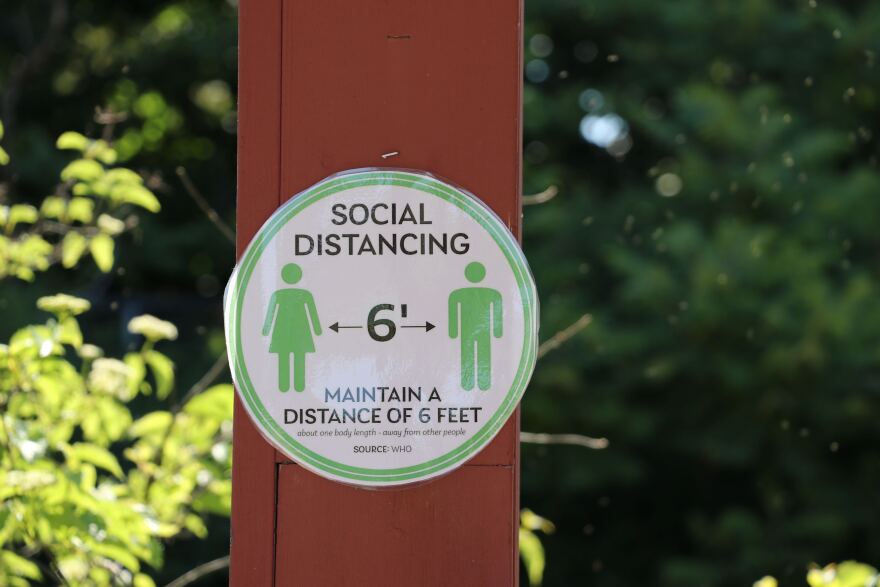COVID-19 is altering nearly every aspect of how we live—from the ways we shop, educate our children, work and exercise, to how we access health care and connect with loved ones.
The pandemic also appears to be altering the patterns of how and where people die in New Hampshire, sometimes in unexpected ways.
While the number of deaths in the state attributed to common causes, including cancer and heart disease, have held largely consistent during the past few months, there have been modest differences in the number of deaths from suicide, homicides, and traffic accidents, according to data available through the New Hampshire Division of Vital Records Administration.
And it’s not just how people are dying that's shifting, but also where: Deaths at home are on the rise, while deaths in hospice facilities are declining during the pandemic, according to public records.
These findings provide only an initial snapshot of how the coronavirus pandemic is altering mortality in New Hampshire. With only a few months worth of data, and the relatively small number of deaths in the state, drawing any sweeping conclusions is impossible. But these figures could serve as a harbinger for public health officials as they work to combat COVID-19 and the disruptions it’s causing in how we live, and die, in the months ahead.
What Kills Us
If history is any guide, somewhere between 12,000 and 13,000 people will die in New Hampshire this year. The state’s Vital Records office makes available a variety of information about those deaths, including age, sex, race and ethnicity of the deceased. The agency also tracks the location of a person’s death, as well as the primary cause of death, releasing anonymized data to the public. (Individual death certificates in New Hampshire are considered private and are generally only given to immediate family or other interested parties.)
The state’s database lumps together the million ways a person can die into 113 categories. That includes approximately 20 different forms of cancer, from breast to skin to prostate cancers. Sepsis, meningitis and malnutrition deaths are tracked, as are fatalities from emphysema, alcoholic liver disease and renal failure.
Last week, the state added a new cause of death to its advanced online portal: 2019-nCoV acute respiratory disease, more commonly known as COVID-19.
As of June 22, the state has recorded 339 deaths associated with the coronavirus. Since the start of the year, that’s more than the number of deaths from heart attacks or Alzheimer’s Disease in New Hampshire, according to the database.
While some people—and some public officials—compared COVID-19 to the seasonal flu during the early stages of the pandemic, the disease's impact is already far more devastating.

New Hampshire averaged 40 influenza-related deaths per year during the past eight years, including 33 fatalities this past winter. COVID-19 has already claimed ten times as many lives in New Hampshire since March, with outbreaks continuing to emerge in the state’s nursing home and long-term care facilities.
Where We Are Dying
The pandemic has transformed our homes into makeshift offices, schools and fitness facilities.
But home has become a place more people in New Hampshire are dying than ever before.
During the first months of the pandemic, data provided by the Division of Vital Records shows a sharp increase in the number of home deaths.
In March and April, an average of 393 deaths were recorded at home per month. That’s a 28 percent increase over those same months during the previous five years.

It isn’t clear why so many more people died inside their homes. Anecdotal evidence suggests many residents avoided emergency rooms during the first weeks of the pandemic, much to the consternation of ER doctors.
“We just don't see the same sick emergency patients in the same numbers that we're used to,” Dr. Mary Valvano, chief of emergency medicine at Portsmouth Regional Hospital, told NHPR in April. “Honestly, we're worried that they're staying home without any treatment.”
Overall, however, New Hampshire has not seen a decline in the number of deaths inside hospitals. The state averaged 316 deaths at hospitals during March and April, largely in line with what was reported during the same months in previous years.
While avoiding medical treatment during a health crisis is likely a bad idea, there is some evidence that people are choosing to die at home surrounded by loved ones, rather than in a licensed hospice facility.
During March and April, the average number of deaths recorded at the state’s two licensed hospice facilities fell to 40, down from an average of 60 recorded deaths during the previous five years.
Andrea Patrick-Baudet, chief clinical officer of Concord Regional Visiting Nurse Association, said her agency is seeing an increase in requests for hospice care in the home, even as its licensed 10-bed hospice house is seeing fewer on-site patients.
For many families, Patrick-Baudet said the pandemic has provided an unexpected opportunity to spend more quality time with a dying loved one.
“Because it is such an intimate and precious time to be home, sharing memories and experiences with your loved ones,” she said. “And so they are actually really receiving that in a very nice way, even though it is a very challenging time.”
Unexpected Shifts in Causes of Death
Though COVID-19 has upended life around the state, it hasn’t had an immediate impact on a large number of causes of death. For example, diseases that generally take months or even years to ultimately claim a person’s life, such as Parkinson’s Disease or heart failure, do not appear to have increased or decreased markedly during the first few months of the pandemic. There are changes, however, for other non-natural causes of death.
Suicide
The number of deaths from suicide appears to have fallen slightly in New Hampshire in 2020. Between January and May of this year, the state recorded 78 suicide deaths. From 2015 to 2019, the state saw an average of 103 deaths from suicide during those same months.
According to Headrest, a Lebanon-based social services non-profit, calls to the state’s suicide prevention hotline are also down in 2020 compared to the previous year.
One possible reason for the downward trend is that the number of suicide deaths, according to one study, may initially decline during periods of crisis, such as a natural disaster.
“There is a consensus among mental health providers that generally, when there is a crisis, that people tend to pull together their resilience and their strength and maybe that gives them a different focus,” said Ken Norton, executive director of the National Alliance on Mental Illness New Hampshire. “And that the mental health crisis tends to come afterwards.”

As economic or other stressors emerge in the months following the initial disaster, rates of suicide could climb. Norton, however, cautioned that the COVID-19 pandemic is uncharted territory and it’s unwise to predict what may happen with rates of suicide in coming months or years.
At the same time, Norton said he does have a reason to be optimistic: Access to mental health treatment has changed dramatically in recent months. Many barriers to remote or telehealth treatment, including insurance restrictions and health privacy concerns, were relaxed during the pandemic. That’s allowed more patients to receive care through phone, video or even text messages with their provider.
Transportation or childcare issues are less likely to get in the way when patients can connect at home, and Norton said he has heard anecdotal evidence that fewer patients are missing or cancelling their teletherapy appointments.
“That’s been an absolute blessing for so many people,” he said.
For those in need of assistance, the National Suicide Prevention Lifeline can be reached at 1-800-273-8255.
Traffic Fatalities
Statewide “stay at home” restrictions, plus the months-long closure of most schools and businesses, led to a rapid decrease in travelers on New Hampshire roadways. During April, the number of vehicles passing through toll booths in New Hampshire fell by more than half compared to the prior year.
Even with so many fewer motorists on the road, the number of traffic-related fatalities is actually up this year.
According to the Department of Safety, through June 1 there were 38 deaths related to automobile accidents in New Hampshire. At the same point last year, the number of traffic fatalities was just 22.
It’s a curious trend that’s not limited to New Hampshire. Nationwide, there was a 14 percent increase in motor vehicle fatalities in March, compared to the previous year, according to the National Safety Council.
“Throughout the country we’re experiencing a significant reduction in vehicle miles travelled, and you would expect to then see a reduction in fatalities,” said Daniel Goodman, with AAA Northern New England. “Deadly crashes have increased in some areas due to drivers using increased speeds on the unusually vacant roads and highways. Speeding increases the risk of a crash, and, the greater the speed, the more likely that crash will be fatal.”
New Hampshire officials are urging drivers to slow down despite the lack of traffic. They also say pedestrians should follow “Walk/Don’t Walk” signals and dress in bright colors when out at night.
Homicides and Overdose Deaths
The pandemic has led to a dramatic reduction in crime, not just in New Hampshire but across the globe.
Since 2005, New Hampshire has averaged approximately 20 homicides per year. In 2019, the state recorded 33 homicides, the largest number during that time period.
Through June of this year, though, the state’s Department of Justice has recorded just five homicides in New Hampshire.

Opioid overdoses, however, may be trending in the opposite direction
“We are seeing the same if not higher numbers of overdoses this year that we saw in 2019,” said Dr. Jennie Duval, Chief Medical Examiner for the state.
According to figures from Duval’s office, there were 198 confirmed or suspected overdose deaths from fentanyl or other opioids between January and May. That’s higher than the same period in 2019, when 179 fatalities were confirmed. In 2018, 195 residents died from overdoses between January and May.








